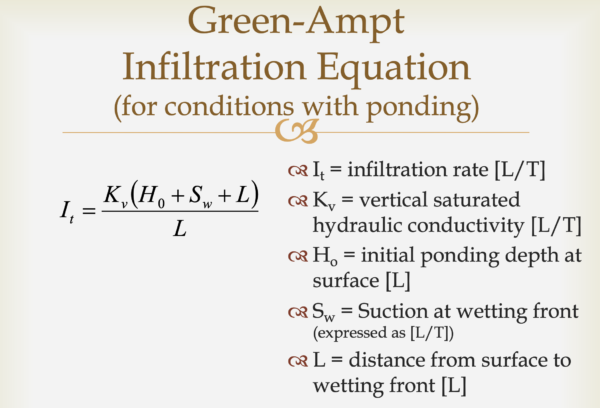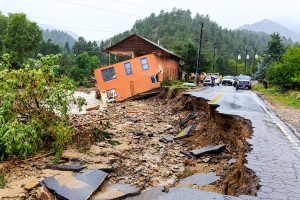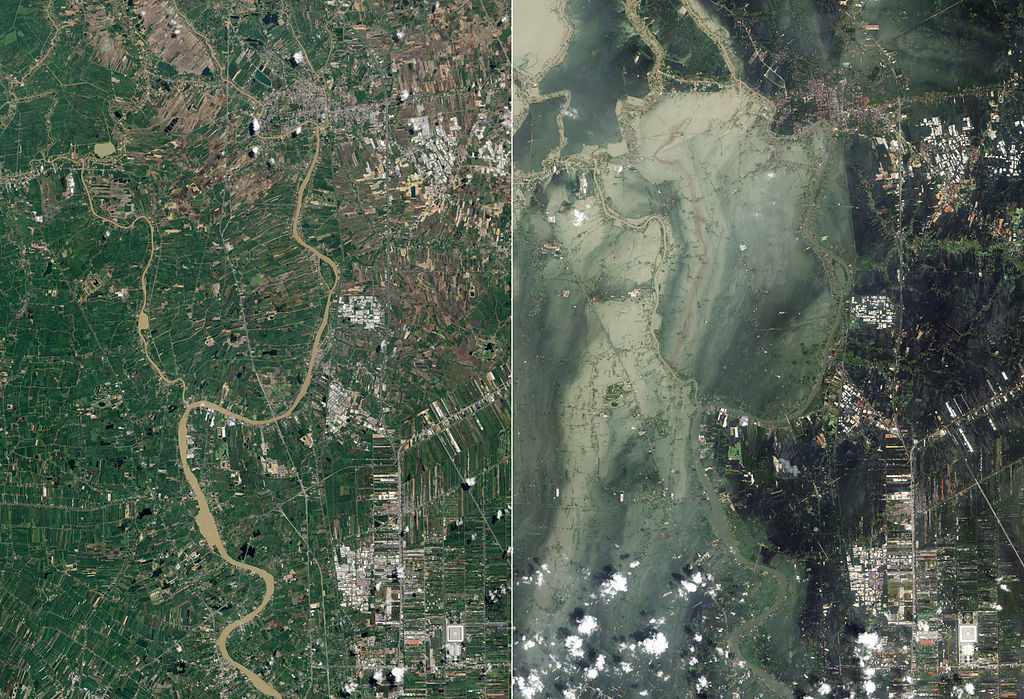This post is part of a series in which I provide the details of each unit I taught post-transitioning to online in Spring 2020 in the Watershed Hydrology class at Kent State University. For more context about the course and my perspective on it, please read the introductory post. [I’ve added some bracketed notes about things I’d change up for a future online offering.]
Finally, we’ve made it to the stream! This section of the course focuses on water flow in streams (streamflow, discharge, Q). We’ll focus on the following topics:
- Why is measuring streamflow important?
- Why does streamflow vary over time?
- How do we measure streamflow?
- How do we find streamflow data?
- What are some hydrologic analyses we can do with streamflow data once we have it?
I have a fair number of different resources to cover these five topics, so I’m going to insert some sub-headers in the material below. You can use them to help you keep track of what you are supposed to be focused on.
Learning Objectives
- List some of the ways that streamflow data are useful.
- Explain why long term stream gauge records are important.
- Describe what a water year is and why it starts when it does
- Identify whether storms contribute a large fraction of total flow in urban streams
- Explain how USGS stream gages work and how stage is measured
- Describe why velocity varies in four dimensions and how velocity is measured
- Explain the function of a rating curve or stage-discharge relationship
- Demonstrate how to identify and download different types of data from the USGS NWIS website
- Explain the appropriate uses, units, and graphical conventions for hydrographs, unit hydrographs, and hydro-hyetographs
- Describe what a flow duration curve is, how to make one, and how to read the flow percentiles off of one
Why is measuring streamflow important?
Streamflow is of course an important output for watershed’s water balance. Plus, it’s a lot easier to measure that evapotranspiration, so accurate measurements of precipitation and streamflow, combined with some simplifying assumptions, can be used to estimate the actual evapotranspiration of an area.
It’s OK to geek out about streamflow data just because you have fallen in love with all things hydrology. But what are the practical reasons to measure streamflow? Why does the USGS operate over 8000 streamgages around the country? This webpage from the USGS Water Science School lists a bunch of really good reasons to measure streamflow and does a great job of slightly expanding on the topics of the video above.
Why does streamflow vary over time?
Streamflow varies by month and year
This USGS Water Science School webpage gives a brief overview of why we need to measure streamflow every day for many years – because it varies seasonally and interannually (across years). In the associated problem set, I have students look at seasonal and internannual patterns of flow (but their graphs will look a little different than the ones the USGS made here, as I ask them to work in unit discharge in metric units.)
Why we need long-term streamflow data
I’ve teed this video up to a key excerpt about why we need long-term streamflow data. This is followed by some good comments about how climate change adds uncertainty to our understanding of streamflow regimes. (The rest of the video is great too, giving an expanded version of why streamgages are important)
What is a water year and why does it start on October 1st?
In this blog post, I explain the rationale behind the timing of the water year in the United States.
How much water flows during storms?
In this USGS Water Science School webpage, you will learn about the magnitude of peak flow and total stormflow relative to baseflow. The page also talks about the characteristic flow regime of urban streams. Note that some streams, especially those sustained by a lot of groundwater, will have a very ratio of stormflow to baseflow over the course of the year.
How do we measure streamflow?
All the things you need to do to measure streamflow
I created this video during an online office hours session, which means that it is really long (50 minutes), has some hilariously bad attempts at drawing with a mouse and unfunny jokes, and there are slides (30 MB, PDF) to go with it. I advised students that it they didn’t want to watch the whole thing, they should look at the slides carefully and then identify the sections of the video they needed to watch in order to check their understanding or gain additional content.
After watching the above video (or not), you should take a look at the videos below that show actual USGS gages and streamflow measurements. You can also get the TL;DR version of how to measure streamflow on the page linked below.
What does a USGS gage look like and how does it measure stage?
I haven’t found the one perfect video that shows you everything I wished you could see about how a stream gage works, but here are two videos that let you peek inside a USGS gage. The first video gives you a good general overview:
This second video gives you the view from a USGS hydrologic technician as she checks on the gage and makes a streamflow measurement.
It is important to note that both of these videos show gages that operate with a stilling well. But USGS gages also use other technology (bubblers, ultrasonic) to measure depth. I just can’t find a video showing these.
Making streamflow measurements
Too much detail in my 50 minute lecture? Or just want to check to make sure you’ve got the important points? Then read this web page straight from the experts at the USGS for the highlights.
Want to see what it actually looks like to make a streamflow measurement by wading or from a bridge? These two videos from the USGS give you a glimpse of the process.
How do we find streamflow data?
The following videos show how to find and access data from USGS stream gages via the National Water Information System. I designed these to be helpful for my students who are required to find, download, and manipulate USGS data in order to complete the associated problem set.
The USGS National Water Information System is the primary portal to streamgage data in the US. It’s important to understand the different ways you can identify a dataset to investigate – or just to see how much water is in your local stream or river.
In this video, I take you on a tour of the streamflow information you can find on the USGS NWIS website, using the Cuyahoga River at Jaite as our example gage. I talk you through what the graphs and tables on the current and historical observations page mean, how to see where the gage is located and look at the availability of other types of data, and then…very importantly for the problem set, I show you how to get to the daily data page, select the date range you want to examine, and save the data to your computer in a way that will be useful for opening in Excel or another spreadsheet program.
This video should help you get data into Excel or Google Sheets to complete the problem set 10. If you use a different browser or spreadsheet program, your may find that things are slightly different than what I do, but you can usually google or find a youtube explainer for how to do the file saving and importing.
If you use Google Sheets, create a new sheet, then go to file –> import data. Locate your saved txt file and then a menu like the one below should pop up. Leave everything as it is and click the big green “import data” button and you will have your data into columns properly. Then you can tidy it up as shown in the video above.
In this video, I show you three ways to examine the field measurements of discharge that underpin the continuous timeseries of streamflow you can find on the US Geological Survey (USGS) National Water Information Service (NWIS) website. I show you how to display the measurements on a graph of streamflow, where to see the actual rating curve, and the way to access the tabular data showing individual field measurements. Put together, all of these things should give you a small sense of how hard USGS hydrologic technicians work to produce good quality streamflow data.
What are some hydrological analyses we can do with streamflow data?
Oregon State University has some excellent tutorials on streamflow analysis techniques. From the page linked here, you can go to pages on: annual analyses; monthly analysis; flow-duration analysis; and flood frequency analysis. These pages have links to examples and tutorials, including with Excel screenshots.
I have adapted these tutorials into my own guide (PDF) to making hydrographs, constructing flow duration curves, and conducting a flood frequency analysis. [Note: I discovered this year that some students got thrown off by the equation that told them to multiply the probability (P) by 100 to get to %. Then, when I told them that recurrence interval was 1 / P their numbers were incorrect. I will fix this in a future year.]
In the video below, I talk through some of the basic ways we can examine and analyze stream discharge data: hydrographs, unit hydrographs, flow duration curves, and runoff ratios. I provide some pointers on how to make effective and visually appealing graphs. This video shows the sorts of graphs students make as they work on the associated problem set.
Just want to look at the slides instead? Here you go (21 MB, PDF).
Assessment
- 10 question multiple choice quiz, with questions drawn from a larger bank. Students had the opportunity to take the quiz twice.
- Problem Set in which students download daily USGS data from 2 streams, construct unit hydrographs and flow duration curves and compute some basic metrics. Students are then asked to write a few paragraphs contrasting the streamflow regimes and explaining why they see the patterns they do based on climate and landscape. Students have already delineated the watersheds and computed watershed characteristics using StreamStats in an earlier problem set.
- Questions on the final exam.
Please respect my work
This work (my videos and blog posts) are licensed under an Attribution-NonCommercial-NoDerivs 3.0 Unported (CC BY-NC-ND 3.0). That means that you need to give appropriate credit if you use or modify anything I’ve posted here. It also means that you can’t use the material for commercial purposes. If you want to use other resources I’ve listed above, please respect the rights of the originators. If you want to use my sequencing of topics and resources in your class, by all means, go ahead.










Nice plan for content warnings on Mastodon and the Fediverse. Now you need a Mastodon/Fediverse button on this blog.